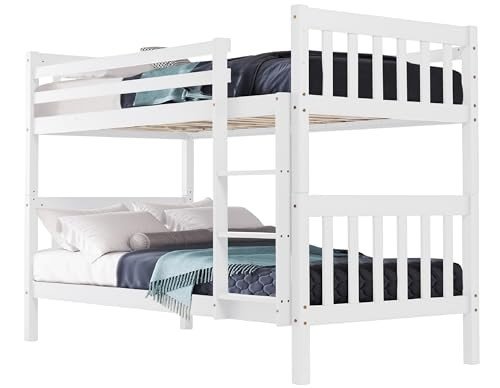Bunks: The Versatile Space-Saving Solution for Modern Living
In today's fast-paced world, where urban home are shrinking and the demand for adaptability and practicality is increasing, bunks have actually emerged as a popular option. Bunks are not simply a kind of bed; they represent an advanced approach to taking full advantage of space, promoting social interaction, and providing comfy sleeping plans. This article will check out the different kinds of bunks readily available, their benefits, and how they can change both small and big living areas.
Understanding Bunks: What Are They?
Bunks, typically referred to as bunk beds, are 2 or more beds stacked on top of each other. click the up coming internet site are developed to save flooring space, making them perfect for children's spaces, hostels, and even adult living scenarios. Bunk beds are available in different designs and configurations, from conventional designs to modern, designer analyses.
Kinds of Bunks
| Type of Bunk | Description |
|---|---|
| Twin-over-Twin | 2 twin beds stacked on top of each other. Suitable for kids sharing a room. |
| Twin-over-Full | A twin bed on the top and a larger complete bed on the bottom. Great for accommodating visitors. |
| Full-over-Full | Two full-sized beds stacked together. Perfect for older kids or adults. |
| L-Shaped Bunk Bed | Beds are organized in an L shape, enabling for a corner placement and added space underneath. |
| Loft Beds | Only the leading bunk exists, leaving space for a desk, sofa, or storage beneath. |
| Triple Bunk Beds | Three beds stacked vertically, outstanding for making the most of vertical space. |
Advantages of Using Bunks
- Space Efficiency: Bunks are created to use vertical space, making them perfect for small bed rooms or apartment or condos where flooring space is limited.
- Affordable: Investing in a bunk bed can be more affordable than buying multiple separate beds, especially for growing families or those with regular visitors.
- Flexible Designs: Many bunks featured add-ons, such as desks, storage drawers, or futons, enabling versatile use of the area.
- Social Interaction: Bunk beds invite camaraderie among siblings and pals, fostering a sense of connection.
- Imaginative Use of Space: Bunk beds encourage imagination in room design, permitting lively styles and colorful decor that can make a bed room feel special and welcoming.
Practical Considerations
- Height Limitations: When picking a bunk bed, it is important to consider the height of the ceiling in the room. Step the space to make sure there is appropriate clearance above the top bunk for safety and convenience.
- Weight Restrictions: Each bunk has a specific weight limitation. Moms and dads need to evaluate the weight of those using it, particularly when it comes to adults or much heavier adolescents sharing the bed.
- Security Features: Features such as guardrails, sturdy ladders, and safety accreditations are essential for guaranteeing the bunk bed's security, especially for younger users.
Bunks for Various Living Situations
Household Homes
In family homes, bunks provide a useful solution for brother or sisters sharing a space or accommodating slumber parties. Bunk beds can be stylishly integrated into a child's space while supplying ample room for play.
Hostels and Vacation Rentals
For hostels and holiday leasings, bunk beds make the most of sleeping arrangements without compromising convenience. Such setups provide an economical method to accommodate a bigger variety of visitors.
College Dormitories
In college dormitories, bunks help make the most of the minimal square footage offered, enabling for more room to socialize and study.
Small Apartments
In little metropolitan apartment or condos, lofted bunk beds create additional space for living areas, work areas, or storage, making life more workable in compact environments.
Maintenance and Care of Bunks
Maintaining a bunk bed is essential for guaranteeing its longevity. Here are a couple of suggestions:
- Regular Inspections: Check for any loose screws or bolts and tighten them as essential.
- Tidiness: Dust and tidy the bunks regularly to prevent irritants and ensure a tidy sleeping environment.
- Bed mattress Care: Use a quality bed mattress protector to keep health and extend the life of the bed mattress.
- Age Appropriateness: Upgrade to a bigger, more durable bunk as kids grow or when the present plan no longer meets the needs of its occupants.
Regularly Asked Questions (FAQs)
1. Are bunk beds safe for children?
Yes, bunk beds can be safe for kids if they are constructed with security functions like guardrails and a steady ladder. Always monitor younger kids when they are utilizing bunk beds.
2. What age is appropriate for a kid to sleep on the top bunk?
Many makers suggest that children under the age of 6 need to not sleep on the upper bunk due to security concerns.
3. How much weight can bunk beds usually hold?
Weight capabilities differ based upon the design and materials however typically vary from 200 to 400 pounds. Constantly check the manufacturer's guidelines.
4. Can bunk beds be separated into 2 single beds?
Numerous bunk beds are created to be convertible, allowing them to be separated into 2 individual beds. It's important to check the product specs before purchasing.
5. What sort of mattress is best for a bunk bed?
A medium-firm bed mattress is frequently suggested as it supplies appropriate support without being too heavy or soft, which can position security issues.
Bunks are more than simply beds. They are ingenious space-saving services that accommodate the requirements of contemporary living. With different styles readily available, they provide comfort and functionality for families, visitors, and people alike. By prioritizing security and maintenance, owners can ensure that their bunk beds become a treasured part of their home for numerous years to come. Whether for spirited kids or accommodating guests, bunk beds use a stylish and practical option to the difficulty of restricted space.

